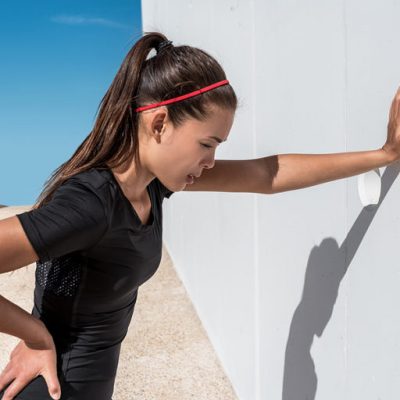
Give Your Wellness a Shot with MIC B12
December 8, 2021
How to Help & Prevent Dehydration Headaches
December 14, 2021
Table of Contents
- What Is Altitude Sickness?
- What Are The First Signs Of Altitude Sickness?
- Treating Altitude Sickness
- Preventing Altitude Sickness
- Altitude Sickness IV Therapy In Arizona
Arizona has a lot of majestic landscapes to explore. The Grand Canyon, of course, but also the hiking trails of Humphreys Peak, the breathtaking vistas from Agassiz Peak, the red cliffs of Sedona, and the popular Camelback Mountain, but it’s hard to enjoy all the beauty of Arizona if you feel nauseous or short of breath. This is called altitude sickness.
It can be uncomfortable dealing with altitude sickness in Phoenix, Tucson, and other well-known destinations in the state. If you find yourself grappling with this issue, you want quick relief that will get you back up on your feet. IV therapy is an ideal solution for high altitude relief because it provides fast, effective relief of these symptoms.
Our safe, effective IV treatment gives you the rehydrating power of an IV with the additional benefit of vitamins, minerals, and nutrients that boost your body’s recovery power. Let us help you get back on your feet and onto your next hike in the beautiful vistas of Arizona.
Mobile IV Nurses is a leading provider of IV treatment for altitude sickness throughout Arizona. For instance, even though Phoenix’s elevation is relatively low, traveling to any of the city’s surrounding mountain ranges may make you feel ill.
We understand how easy it is to get sick while adjusting to changes in altitude and how destabilizing it can be. That’s why we provide high altitude relief with IV therapy, which effectively treats the symptoms of altitude sickness and helps you feel like yourself again. To understand how to recover from altitude sickness, you have to learn more about its root causes.
What Is Altitude Sickness?
The higher the elevation, the lower the available oxygen levels and air pressure. This can make you more likely to suffer from altitude sickness. Some factors that increase your risk for altitude sickness include:
- Traveling too quickly from sea level to a high altitude
- A history of altitude sickness during past travels
- Not enough time spent getting used to the conditions at higher altitudes
- Alcohol or substance use
- Medical issues with your heart, lungs, or nervous system
You also may be more likely to get sick at higher altitudes depending on your age, weight, and blood pressure.
Altitude sickness is often referred to as acute mountain sickness, or AMS, which is the most common form of this illness. Unsurprisingly, AMS is a progressive problem that worsens the higher up you go in elevation. In Sedona, Arizona, altitude sickness may not be an issue in the town itself, but go up to nearby Wilson Mountain, and the change in elevation (from 4,350 feet to 7,122 feet) may leave you feeling queasy and looking for high-altitude relief.
In fact, there are many different areas in Arizona featuring a dramatic change between lower-elevation cities and their nearby peaks. For example, the city of Tucson is at an elevation of 2,389 feet (0.73 km), but the nearby peak of Mt. Lemmon goes up to 9,147 feet (2.79 km). This change of nearly 7,000 feet (2.13 km) can easily start to make you feel altitude sickness symptoms! It can even affect the most seasoned and experienced hikers.
AMS intensifies for many people once they pass 10,000 feet in elevation. That means if you’re tackling the trail at Humphreys Peak, the highest point in Arizona at 12,633 feet, you have a greater risk of altitude sickness. You may also be more susceptible to two other, more serious forms of altitude sickness. High-altitude pulmonary edema (HAPE) can cause dangerous fluid build-up in the lungs, while high-altitude cerebral edema (HACE) leads to brain swelling.
AMS moves from mild to moderate to severe in intensity and can happen quite rapidly. The most advanced cases of these conditions require medical attention because they can be dangerous to your health. That’s why it’s important to address altitude sickness as soon as possible.
What Are The First Signs Of Altitude Sickness?
In Arizona, altitude sickness is a common concern. Even though the Phoenix, Arizona elevation isn’t as high as other areas, traveling to higher points in the mountains nearby can easily start to make you feel common symptoms of altitude sickness.
Keep an eye out for the following indications that you might be suffering from symptoms of altitude sickness:
Early, mild symptoms:
- Headaches
- Shortness of breath
- Fatigue
- Queasiness
- Appetite loss
- Light-headedness
- Disrupted sleep
Moderate symptoms:
- Nausea or vomiting
- Uncoordinated, unstable movement
- Elevated heart rate
- Difficulty breathing, especially during physical activity
Severe symptoms:
- Brain fogginess
- A cough that may produce blood
- A tight feeling in the chest
- A bluish tint to the skin
- Loss of balance
- Shortness of breath
- Fluid in the lungs

These severe symptoms may require a doctor’s visit or a trip to the hospital emergency room. Don’t reach that point; address altitude sickness symptoms when they’re mild, so you feel better quicker. If you find yourself in locations such as Sedona, the Grand Canyon National Park, or Tucson, altitude sickness relief is close at hand with mobile IV treatment.
Treating Altitude Sickness
If you feel woozy or have a headache coming on while going up Camelback Mountain, for instance, return to the lower Phoenix altitude as soon as possible. This will make it easier for your body to return to normal.
Once you’re safely down, take time to rest and give your body a chance to recover. Limit your physical activity—that means avoiding exercise, but you may also want to avoid too much standing or walking. If you’re struggling to breathe, you may need supplemental oxygen until you can lower your respiratory rate. It may take up to 36 hours for symptoms to subside. If you see a doctor for your altitude sickness, you might get a prescription medication to relieve the physical effects of your illness.
If it’s hard to shake those symptoms, and you’re worried they’ll get worse, try IV therapy. An IV for altitude sickness can bring much-needed relief. IV therapy helps alleviate symptoms related to altitude sickness, and it also offers a fast infusion of fluids, which can ease any dehydration caused by your illness.
IV fluids are rich in vitamins, minerals, and electrolytes the body needs to function properly. The fluids start working immediately because they are infused into the bloodstream. It may take longer to feel relief from typical oral medications used for altitude sickness because they have to travel through the digestive system before being absorbed into the bloodstream. This is one reason why IV therapy is growing in popularity as a treatment used for several health conditions, including altitude sickness.
Preventing Altitude Sickness
Of course, taking the proper precautions against altitude sickness can help you avoid any problems, so you can enjoy your day in the mountains and hills of Arizona. Here are some simple strategies to take before and during your adventures:
- Don’t rush yourself: Be smart when planning your schedule. Build in a rest day when you first arrive at a location with high elevation so your body can acclimate to the thinner air. Then you’ll be better prepared for vigorous activity.
- Watch what you drink: Plan to drink plenty of water at higher elevations because dehydration can go hand in hand with altitude sickness. Drink at least 11 to 13 cups of water each day, and even more if you’re going to be exercising in hot weather. Conversely, avoid alcohol consumption as much as possible, but if you do indulge, don’t drink too much. Alcohol has a diuretic effect that depletes the body’s fluid levels. This can lead to dehydration, which amplifies the symptoms of altitude sickness such as fatigue, headaches, and dizziness.
- Snack smartly: High elevations and low oxygen levels can sap you of energy and drag you down. Fortify yourself with healthy carbs that are a powerful energy source. Pack portable snacks such as veggies, whole grains, and, of course, trail mix!
- Listen to your body: Don’t try to power through the pain if you’ve got symptoms of altitude sickness. You may think you can just tough it out until you feel better, but AMS can get worse if you don’t stop it in its tracks. Got a headache? Take a water break. Losing your energy on the mountain? Find some shade and eat one of your snacks. And if the altitude sickness signs still persist, that’s your body telling you that it’s time to take care of yourself. Slowly make your descent and try to get to a location with a lower elevation if possible. Make sure you’ve got someone who can help you out if you start to have trouble walking or moving on your own.
Altitude Sickness IV Therapy In Arizona
Mobile IV Nurses is a trusted IV service provider in Arizona. We specialize in mobile IV therapy, which means we administer treatments in your home, hotel room, office, or other convenient location. Registered nurses and paramedics perform all treatments, adhering to the highest standards for safety and patient care.
When you schedule an altitude sickness IV therapy with us, we’ll talk to you about your symptoms and health history, so we can find the right treatment for you. In many cases, we recommend the Myers’ Cocktail. This popular IV drip counteracts the symptoms of altitude sickness by increasing energy and eliminating fatigue. This is achieved with a precise combination of vitamin B12, B Complex, vitamin C, magnesium, zinc, and the antioxidant glutathione.
Struggling with the queasiness that’s all too common at high altitude? You can add an anti-nausea medication such as Zofran to help you feel better. All of our drip IV bags are customizable, so you get the vitamins, minerals, supplements, or medications that your body needs.
Once you choose an IV treatment with Mobile IV Nurses, our medical professionals will gently insert a needle into your arm, which is removed and only a plastic tube remains in place for your IV therapy. The plastic IV is attached to a tube leading to the drip IV bag. At that point you get to relax and be comfortable during the infusion; we’ll monitor you carefully during treatment to ensure everything goes smoothly. When the IV session is over—typically after 45-60 minutes—the plastic catheter is removed, and a bandage is placed on your arm. Some people report feeling a noticeable difference in their symptoms right away. We recommend that you take it easy and regain your strength until you feel stronger.
Contact Mobile IV Nurses For An Altitude Sickness IV
Do you feel low at high elevations? Contact Mobile IV Nurses for help. It’s easy to get symptom relief for altitude sickness in Phoenix, Flagstaff, Sedona, Tucson, or another location, thanks to our multiple service areas throughout the state. We also offer various pricing packages that meet every need and budget. All of our IV drips use high-quality, medical-grade ingredients and our years of expertise guarantee you’ll get trusted, reliable service, making us the leader for mobile IV therapy in Arizona.
Our nurses and paramedics understand the needs of those suffering from altitude sickness. From headaches and fatigue to a general sense of feeling “off,” we’re confident that our IV treatments can help you get back on your feet and hiking in no time.
If you want the best possible treatment for altitude sickness, call on Mobile IV Nurses. Schedule an appointment with us today so you can get back to exploring and enjoying the great outdoors.

Experience the Convenience of At-Home IV Therapy with Mobile IV Nurses
Hydration & Wellness
Professional Care
Convenient Service



